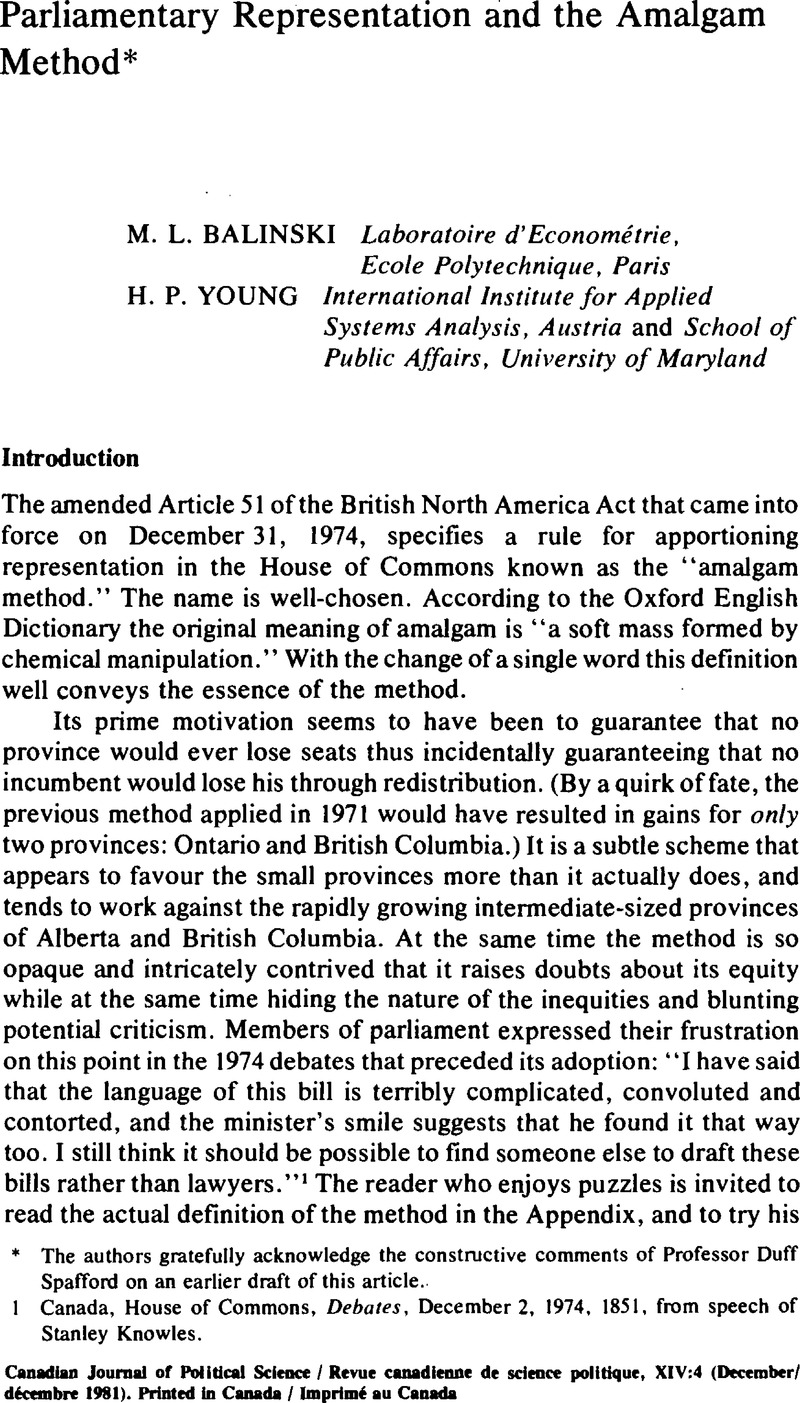Article contents
Parliamentary Representation and the Amalgam Method*
Published online by Cambridge University Press: 10 November 2009
Abstract

- Type
- Research Article
- Information
- Canadian Journal of Political Science/Revue canadienne de science politique , Volume 14 , Issue 4 , December 1981 , pp. 797 - 812
- Copyright
- Copyright © Canadian Political Science Association (l'Association canadienne de science politique) and/et la Société québécoise de science politique 1981
References
1 Canada, House of Commons, Debates, December 2, 1974, 1851, from speech of Stanley Knowles.
2 Canada, Senate, Debates, December 18, 1974, 435Google Scholar, from speech of Grattan O'Leary.
3 The sources are McConnell, W. H., Commentary on the British North America Act (Toronto: Macmillan, 1975)Google Scholar and Article 51 of the Act itself. McConnell's description of the amalgam method is not entirely correct; he errs in his description of the divisor to be applied to the intermediate states.
4 Subsequent discussion of the history and properties of methods draws on the authors' forthcoming book Fair Representation (New Haven: Yale University Press) as well as on a series of papers by the authors in the technical literature. For a summary see Balinski, M. L. and Young, H. P., “The Webster Method of Apportionment,” Proceedings of the National Academy of Sciences USA 77 (1980), 1–4CrossRefGoogle ScholarPubMed (hereinafter referred to as The Webster Method).
5 The method now used to apportion the United States House of Representatives is a more complicated divisor method in which a quotient is rounded up if it is greaterthan the square root of the product of the two nearest whole numbers. Thus a quotient of 2.450 would be rounded up to 3 because it is greater than the square root of 2 times 3 (about 2.449).
6 The fair share is also called the quota (see The Webster Method).
7 House of Commons, Debates, December 2, 1974, p. 1845, from speech of Mitchell Sharp.
8 This principle embodies the technical properties of homogeneity and symmetry (see The Webster Metho d).
9 Examples from United States history which show that the Hamilton method admits the population paradox may be found in Fair Representation.
10 Technically, a homogeneous and symmetric method avoids the population paradox if it is impossible for a province that has increased in population to lose seats and at the same time a province that has decreased in population to gain seats. If, in addition, the method gives exactly the fair shares whenever these shares are all whole numbers, then essentially it must be a divisor method. The proof may be found in Fair Representation.
11 Debates, December 2, 1974, p. 1846, from speech of Mitchell Sharp.
12 The adjusted fair shares, also called modified quotas in Fair Representation, are defined as follows: f pi is the population of province i, r1 is its minimum floor, and his the number of seats or house size, find x such that ∑jn max {p1/x, r1} = h. The numbers q1 = max {pi/x, r1} are the adjusted fair shares.
13 Debates, December 2, 1974, 1850, from speech of Stanley Knowles.
14 Ibid.
15 A method is biased if over many problems it tends to give some class of provinces more (or less) than i:s fair share. It can be shown that Webster's method is the only divisor method satisfying certain regularity conditions that is unbiased. This is done from several differeit points of view in Fair Representation.
16 The Adams apportionment is found with the divisor 79,000 and rounding every quotient up (except for Prince Edward Island to satisfy the floor of 4). The Webster apportionment is foi ind with the divisor 78,100. The Jefferson apportionment is found with the divisor 77,000 and rounding every quotient down (except for Prince Edward Island).
17 A formal proof that the Webster method is characterized as the one divisor method that is near the fair shares is given in Fair Representation.
18 Divisors that provide the solutions are as follows: for Adams, 79,400; for Webster, 79,000; for Jefferson, 77,250.
19 This fact is prove in Fair Representation.
20 As enacted by the iritish North America Act, S.C. 1974–75–76, c. 13, which came into force on December 31, 1974.
- 3
- Cited by




